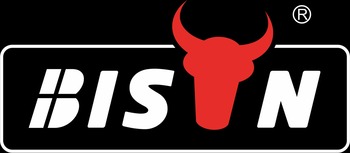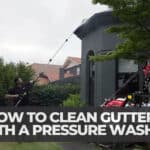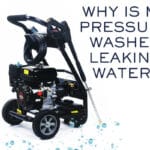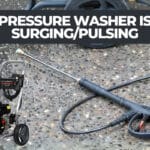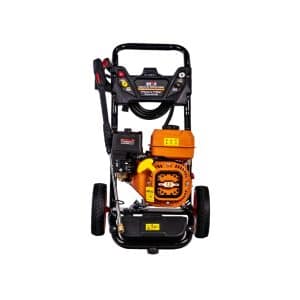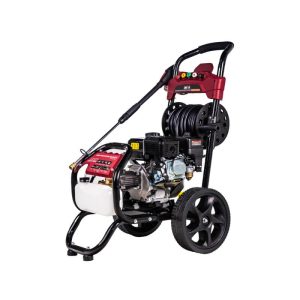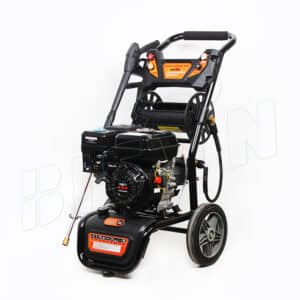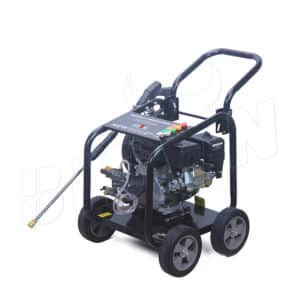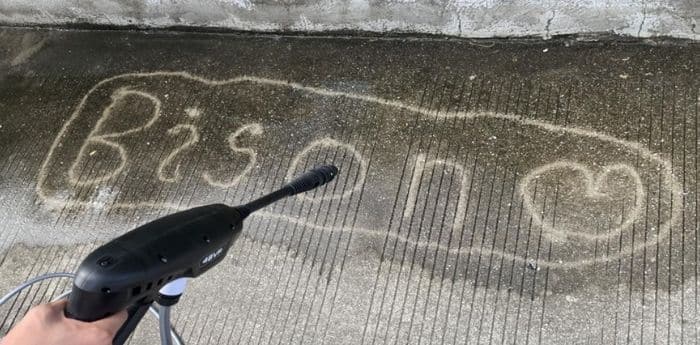

BISON Santy
Hola, soy Santy, el fundador de bisonclean.com. He estado en el campo de la maquinaria de limpieza desde hace más de 5 años, y el propósito de este artículo es compartir con ustedes los conocimientos relacionados con la lavadora a presión desde la perspectiva de un proveedor chino.
Índice
Las hidrolimpiadoras son herramientas de limpieza muy útiles. Se utilizan comúnmente en entornos residenciales y comerciales para limpiar entradas de vehículos, casas, vehículos y barcos, y estas diferentes tareas de limpieza requieren diferentes patrones y presiones de chorro de agua. Por eso necesitamos este cambio de boquilla para hidrolimpiadoras. Cambiar la boquilla de la hidrolimpiadora puede transformar drásticamente la eficacia de su limpieza. Como fabricante de hidrolimpiadorasBISON tiene una amplia experiencia en limpiadoras a presión. En este artículo, le mostraremos cómo sustituir la boquilla de una hidrolimpiadora paso a paso. Así que ¡empieza a leer!
Tipos de boquillas para hidrolimpiadoras
![{"type": "elementor", "siteurl": "https://www.bisonclean.com/wp-json/", "elements":[{"id": "fe4eafa", "elType": "widget", "isInner":false, "isLocked":false, "settings":{"image":{"url": "https://www.bisonclean.com/wp-content/uploads/2024/02/How-to-change-the-pressure-washer-nozzle.jpg","id":14917,"size":"","alt":"","source":"library"},"image_size":"medium_large","image_custom_dimension":{"width":"","height":""},"caption_source":"none", "caption":"", "link_to": "none", "link":{"url":"", "is_external":"", "nofollow":"", "custom_attributes":""}, "open_lightbox": "default", "align":"", "align_tablet":"","align_mobile":"","width":{"unit":"%","size":"","sizes":[]},"width_tablet":{"unit":"%","size":"","sizes":[]},"width_mobile":{"unit":"%","size":"","sizes":[]},"space":{"unit":"%","size":"","sizes":[]},"space_tablet":{"unit":"%","size":"","sizes":[]},"space_mobile":{"unit":"%","size":"","sizes":[]},"height":{"unit":"px","size":"","sizes":[]},"height_tablet":{"unit":"px","size":"","sizes":[]},"height_mobile":{"unit":"px","size":"","sizes":[]},"object-fit":"", "object-fit_tablet":"", "object-fit_mobile":"", "object-position": "center center", "object-position_tablet":"", "object-position_mobile":"", "opacity":{"unit":"px","size":"","sizes":[]},"css_filters_css_filter":"","css_filters_blur":{"unit":"px","size":0,"sizes":[]},"css_filters_brightness":{"unit":"px","size":100,"sizes":[]},"css_filters_contrast":{"unit":"px","size":100,"sizes":[]},"css_filters_saturate":{"unit":"px","size":100,"sizes":[]},"css_filters_hue":{"unit":"px","size":0,"sizes":[]},"opacity_hover":{"unit":"px","size":"","sizes":[]},"css_filters_hover_css_filter":"","css_filters_hover_blur":{"unit":"px","size":0,"sizes":[]},"css_filters_hover_brightness":{"unit":"px","size":100,"sizes":[]},"css_filters_hover_contrast":{"unit":"px","size":100,"sizes":[]},"css_filters_hover_saturate":{"unit":"px","size":100,"sizes":[]},"css_filters_hover_hue":{"unit":"px","size":0,"sizes":[]},"background_hover_transition":{"unit":"px","size":"","sizes":[]}, "hover_animation":"", "image_border_border":"", "image_border_width":{"unit": "px", "top":"", "right":"", "bottom":"", "left":"", "isLinked":true}, "image_border_width_tablet":{"unit":"px","top":"","right":"","bottom":"","left":"","isLinked":true},"image_border_width_mobile":{"unit":"px","top":"","right":"","bottom":"","left":"", "isLinked":true}, "image_border_color":"", "image_border_radius":{"unit": "px", "top":"", "right":"", "bottom":"", "left":"", "isLinked":true}, "image_border_radius_tablet":{"unit":"px","top":"","right":"","bottom":"","left":"","isLinked":true},"image_border_radius_mobile":{"unit":"px","top":"","right":"","bottom":"","left":"", "isLinked":true}, "image_box_shadow_box_shadow_type":"", "image_box_shadow_box_shadow":{"horizontal":0, "vertical":0, "blur":10, "spread":0, "color": "rgba(0,0,0,0.5)"}, "caption_align":"", "caption_align_tablet":"", "caption_align_mobile":"", "text_color":"", "caption_background_color":"", "caption_typography_typography":"", "caption_typography_font_family":"", "caption_typography_font_size":{"unit": "px", "size":"", "sizes":[]}, "caption_typography_font_size_tablet":{"unit": "px", "size":"", "sizes":[]}, "caption_typography_font_size_mobile":{"unit": "px", "size":"", "sizes":[]}, "caption_typography_font_weight":"", "caption_typography_text_transform":"", "caption_typography_font_style":"", "caption_typography_text_decoration":"", "caption_typography_line_height":{"unidad": "px", "tamaño":"", "tamaños":[]}, "caption_typography_line_height_tablet":{"unidad": "em", "tamaño":"", "sizes":[]}, "caption_typography_line_height_mobile":{"unit": "em", "size":"", "sizes":[]}, "caption_typography_letter_spacing":{"unit": "px", "size":"", "sizes":[]}, "caption_typography_line_spacing":{"unit": "px", "size":"", "sizes":[]}:[]}, "caption_typography_letter_spacing_tablet":{"unit": "px", "size":"", "sizes":[]}, "caption_typography_letter_spacing_mobile":{"unit": "px", "size":"", "sizes":[]}, "caption_typography_word_spacing":{"unit": "px", "size":"", "sizes":[]}, "caption_typography_word_spacing_tablet":{"unit": "em", "size":"", "sizes":[]}, "caption_typography_word_spacing_mobile":{"unit":"em", "size":"", "sizes":[]}, "caption_text_shadow_text_shadow_type":"", "caption_text_shadow_text_shadow":{"horizontal":0, "vertical":0, "blur":10, "color": "rgba(0,0,0,0.3)"},"caption_space":{"unit":"px","size":"","sizes":[]},"caption_space_tablet":{"unit":"px","size":"","sizes":[]},"caption_space_mobile":{"unit":"px","size":"","sizes":[]},"_title":"","_margin":{"unit":"px","top":"","right":"","bottom":"","left":"","isLinked":true},"_margin_tablet":{"unit":"px","top":"","right":"","bottom":"","left":"","isLinked":true},"_margin_mobile":{"unit":"px","top":"","right":"","bottom":"","left":"","isLinked":true},"_padding":{"unit":"px","top":"","right":"","bottom":"","left":"","isLinked":true},"_padding_tablet":{"unit":"px","top":"","right":"","bottom":"","left":"","isLinked":true},"_padding_mobile":{"unit":"px","top":"","right":"","bottom":"", "izquierda":"", "isLinked":true},"_element_width":"","_element_width_tablet":"","_element_width_mobile":"","_element_custom_width":{"unit":"%","size":"","sizes":[]},"_element_custom_width_tablet":{"unit":"px","size":"","sizes":[]},"_element_custom_width_mobile":{"unit":"px","size":"","sizes":[]},"_flex_align_self":"","_flex_align_self_tablet":"","_flex_align_self_mobile":"","_flex_order":"","_flex_order_tablet":"","_flex_order_mobile":"","_flex_order_custom":"","_flex_order_custom_tablet":"","_flex_order_custom_mobile":"","_flex_size":"","_flex_size_tablet":"","_flex_size_mobile":"","_flex_grow":1,"_flex_grow_tablet":"","_flex_grow_mobile":"","_flex_shrink":1,"_flex_shrink_tablet":"","_flex_shrink_mobile":"","_element_vertical_align":"","_element_vertical_align_tablet":"","_element_vertical_align_mobile":"","_position":"","_offset_orientation_h":"start","_offset_x":{"unit":"px","size":0,"sizes":[]},"_offset_x_tablet":{"unit":"px","size":"","sizes":[]},"_offset_x_mobile":{"unit":"px","size":"","sizes":[]},"_offset_x_end":{"unit":"px","size":0,"sizes":[]},"_offset_x_end_tablet":{"unit":"px","size":"","sizes":[]},"_offset_x_end_mobile":{"unit":"px","size":"","sizes":[]},"_offset_orientation_v":"start","_offset_y":{"unit":"px","size":0,"sizes":[]},"_offset_y_tablet":{"unit":"px","size":"","sizes":[]},"_offset_y_mobile":{"unit":"px","size":"","sizes":[]},"_offset_y_end":{"unit":"px","size":0,"sizes":[]},"_offset_y_end_tablet":{"unit":"px","size":"","sizes":[]},"_offset_y_end_mobile":{"unit":"px","size":"","sizes":[]},"_z_index":"","_z_index_tablet":"","_z_index_mobile":"","_element_id":"","_css_classes":"", "display_condition_enable":"", "display_condition_to": "mostrar", "display_condition_relation": "y", "display_condition_list":[{"display_condition_key":"rol", "display_condition_operator": "es", "display_condition_login_status": "suscriptor","_id": "8d7c10e", "display_condition_operator_advanced_date": "menos", "display_condition_date": "01-03-2024", "display_condition_day": "lunes", "display_condition_role":"suscriptor", "display_condition_browser": "chrome", "display_condition_operating_system": "mac_os", "display_condition_date_range": "01-03-2024 to 03-03-2024", "display_condition_page":"", "display_condition_post":"", "display_condition_static_page": "home", "display_condition_time_span_start":"10:00", "display_condition_time_span_end": "11:00", "display_condition_visitor_type": "new", "display_condition_request_parameter_key":"", "display_condition_request_parameter_value":"", "display_condition_advanced_date": "01-03-2024", "display_condition_geolocation":"", "display_condition_acf_text_key":"", "display_condition_acf_text_value":""}], "display_condition_time_zone": "local", "trp_language_restriction":"", "trp_language_restriction_automatic_translation":"", "trp_restricted_languages":"", "trp_exclude_handler":"", "trp_excluded_languages":"", "motion_fx_motion_fx_scrolling":"", "motion_fx_translateY_effect":"", "motion_fx_translateY_direction":"", "motion_fx_translateY_speed":{"unit":"px","size":4,"sizes":[]},"motion_fx_translateY_affectedRange":{"unit":"%","size":"","sizes":{"start":0,"end":100}}, "motion_fx_translateX_effect":"", "motion_fx_translateX_direction":"", "motion_fx_translateX_speed":{"unit": "px", "size":4, "sizes":[]}, "motion_fx_translateX_affectedRange":{"unidad": "%", "tamaño":"", "tamaños":{"inicio":0, "fin":100}}, "motion_fx_opacity_effect":"", "motion_fx_opacity_direction":"out-in","motion_fx_opacity_level":{"unit":"px","size":10,"sizes":[]},"motion_fx_opacity_range":{"unit":"%","size":"","sizes":{"start":20,"end":80}},"motion_fx_blur_effect":"","motion_fx_blur_direction":"out-in","motion_fx_blur_level":{"unit":"px","size":7,"sizes":[]},"motion_fx_blur_range":{"unit":"%","size":"","sizes":{"start":20,"end":80}},"motion_fx_rotateZ_effect":"","motion_fx_rotateZ_direction":"", "motion_fx_rotateZ_speed":{"unidad": "px", "tamaño":1, "tamaños":[]}, "motion_fx_rotateZ_affectedRange":{"unidad": "%", "tamaño":"","sizes":{"start":0,"end":100}},"motion_fx_scale_effect":"","motion_fx_scale_direction":"out-in","motion_fx_scale_speed":{"unit":"px","size":4,"sizes":[]},"motion_fx_scale_range":{"unit":"%","size":"","sizes":{"start":20,"end":80}},"motion_fx_transform_origin_x":"center", "motion_fx_transform_origin_y": "center", "motion_fx_devices":["desktop", "tablet", "mobile"], "motion_fx_range":"", "motion_fx_motion_fx_mouse":"", "motion_fx_mouseTrack_effect":"", "motion_fx_mouseTrack_direction":"", "motion_fx_mouseTrack_speed":{"unidad": "px", "tamaño":1,"sizes":[]},"motion_fx_tilt_effect":"","motion_fx_tilt_direction":"","motion_fx_tilt_speed":{"unit":"px","size":4,"sizes":[]},"sticky":"", "sticky_on":["desktop", "tablet", "mobile"], "sticky_offset":0, "sticky_offset_tablet":"", "sticky_offset_mobile":"", "sticky_effects_offset":0, "sticky_effects_offset_tablet":"", "sticky_effects_offset_mobile":"", "sticky_parent":"","_animation":"","_animation_tablet":"","_animation_mobile":"", "animation_duration":"","_animation_delay":"","_transform_rotate_popover":"","_transform_rotateZ_effect":{"unit": "px", "size":"", "sizes":[]},"_transform_rotateZ_effect_tablet":{"unit": "deg", "size":"", "sizes":[]},"_transform_rotateZ_effect_mobile":{"unit": "deg", "size":"","sizes":[]},"_transform_rotate_3d":"","_transform_rotateX_effect":{"unit":"px","size":"","sizes":[]},"_transform_rotateX_effect_tablet":{"unit":"deg","size":"","sizes":[]},"_transform_rotateX_effect_mobile":{"unit":"deg","size":"","sizes":[]},"_transform_rotateY_effect":{"unit": "px", "size":"", "sizes":[]},"_transform_rotateY_effect_tablet":{"unit": "deg", "size":"", "sizes":[]},"_transform_rotateY_effect_mobile":{"unit": "deg", "size":"", "sizes":[]},"_transform_perspective_effect":{"unit": "px", "size":"", "sizes":[]},"_transform_perspective_effect_tablet":{"unit":"px","size":"","sizes":[]},"_transform_perspective_effect_mobile":{"unit":"px","size":"","sizes":[]},"_transform_translate_popover":"","_transform_translateX_effect":{"unit": "px", "size":"", "sizes":[]},"_transform_translateX_effect_tablet":{"unit": "px", "size":"", "sizes":[]},"_transform_translateX_effect_mobile":{"unit": "px", "size":"", "sizes":[]},"_transform_translateY_effect":{"unit": "px", "size":"", "sizes":[]},"_transform_translateY_effect_tablet":{"unit": "px", "size":"", "sizes":[]},"_transform_translateY_effect_mobile":{"unit": "px", "size":"", "sizes":[]},"_transform_scale_popover":"","_transform_keep_proportions": "yes","_transform_scale_effect":{"unit":"px","size":"","sizes":[]},"_transform_scale_effect_tablet":{"unit":"px","size":"","sizes":[]},"_transform_scale_effect_mobile":{"unit":"px","size":"","sizes":[]},"_transform_scaleX_effect":{"unit":"px","size":"","sizes":[]},"_transform_scaleX_effect_tablet":{"unit":"px","size":"","sizes":[]},"_transform_scaleX_effect_mobile":{"unit":"px","size":"","sizes":[]},"_transform_scaleY_effect":{"unit":"px","size":"","sizes":[]},"_transform_scaleY_effect_tablet":{"unit":"px","size":"","sizes":[]},"_transform_scaleY_effect_mobile":{"unit":"px","size":"","sizes":[]},"_transform_skew_popover":"","_transform_skewX_effect":{"unit":"px","size":"","sizes":[]},"_transform_skewX_effect_tablet":{"unit":"deg","size":"","sizes":[]},"_transform_skewX_effect_mobile":{"unit":"deg","size":"","sizes":[]},"_transform_skewY_effect":{"unit":"px","size":"","sizes":[]},"_transform_skewY_effect_tablet":{"unit":"deg","size":"","sizes":[]},"_transform_skewY_effect_mobile":{"unit": "deg", "size":"", "sizes":[]},"_transform_flipX_effect":"","_transform_flipY_effect":"","_transform_rotate_popover_hover":"","_transform_rotateZ_effect_hover":{"unidad": "px", "tamaño":"", "tamaños":[]},"_transform_rotateZ_effect_hover_tablet":{"unidad":"deg","size":"","sizes":[]},"_transform_rotateZ_effect_hover_mobile":{"unit":"deg","size":"","sizes":[]},"_transform_rotate_3d_hover":"","_transform_rotateX_effect_hover":{"unit": "px", "size":"", "sizes":[]},"_transform_rotateX_effect_hover_tablet":{"unit": "deg", "size":"", "sizes":[]}:[]},"_transform_rotateX_effect_hover_mobile":{"unit": "deg", "size":"", "sizes":[]},"_transform_rotateY_effect_hover":{"unit": "px", "size":"", "sizes":[]},"_transform_rotateY_effect_hover_tablet":{"unit": "deg", "size":"", "sizes":[]},"_transform_rotateY_effect_hover_mobile":{"unit":"deg", "size":"", "sizes":[]},"_transform_perspective_effect_hover":{"unit": "px", "size":"", "sizes":[]},"_transform_perspective_effect_hover_tablet":{"unit": "px", "size":"", "sizes":[]},"_transform_perspective_effect_hover_mobile":{"unit": "px", "size":"", "sizes":[]},"_transform_translate_popover_hover":"","_transform_translateX_effect_hover":{"unit": "px", "size":"", "sizes":[]},"_transform_translateX_effect_hover_tablet":{"unit":"px","size":"","sizes":[]},"_transform_translateX_effect_hover_mobile":{"unit":"px","size":"","sizes":[]},"_transform_translateY_effect_hover":{"unit": "px", "size":"", "sizes":[]},"_transform_translateY_effect_hover_tablet":{"unit": "px", "size":"", "sizes":[]}:[]},"_transform_translateY_effect_hover_mobile":{"unit": "px", "size":"", "sizes":[]},"_transform_scale_popover_hover":"","_transform_keep_proportions_hover": "yes","_transform_scale_effect_hover":{"unit": "px", "size":"", "sizes":[]},"_transform_scale_effect_hover_tablet":{"unit":"px","size":"","sizes":[]},"_transform_scale_effect_hover_mobile":{"unit":"px","size":"","sizes":[]},"_transform_scaleX_effect_hover":{"unit":"px","size":"","sizes":[]},"_transform_scaleX_effect_hover_tablet":{"unit":"px","size":"","sizes":[]},"_transform_scaleX_effect_hover_mobile":{"unit":"px","size":"","sizes":[]},"_transform_scaleY_effect_hover":{"unit":"px","size":"","sizes":[]},"_transform_scaleY_effect_hover_tablet":{"unit": "px", "size":"", "sizes":[]},"_transform_scaleY_effect_hover_mobile":{"unit": "px", "size":"", "sizes":[]}:[]},"_transform_skew_popover_hover":"","_transform_skewX_effect_hover":{"unit": "px", "size":"", "sizes":[]},"_transform_skewX_effect_hover_tablet":{"unit":"deg","size":"","sizes":[]},"_transform_skewX_effect_hover_mobile":{"unit":"deg","size":"","sizes":[]},"_transform_skewY_effect_hover":{"unit":"px","size":"","sizes":[]},"_transform_skewY_effect_hover_tablet":{"unit":"deg","size":"","sizes":[]},"_transform_skewY_effect_hover_mobile":{"unit": "deg", "size":"", "sizes":[]},"_transform_flipX_effect_hover":"","_transform_flipY_effect_hover":"","_transform_transition_hover":{"unidad": "px", "tamaño":"", "tamaños":[]}, "motion_fx_transform_x_anchor_point":"", "motion_fx_transform_x_anchor_point_tablet":"", "motion_fx_transform_x_anchor_point_mobile":"", "motion_fx_transform_y_anchor_point":"", "motion_fx_transform_y_anchor_point_tablet":"", "motion_fx_transform_y_anchor_point_mobile":"","_background_background":"","_background_color":"","_background_color_stop":{"unit":"%","size":0,"sizes":[]},"_background_color_stop_tablet":{"unit":"%"},"_background_color_stop_mobile":{"unit":"%"},"_background_color_b":"#f2295b","_background_color_b_stop":{"unit":"%","size":100,"sizes":[]},"_background_color_b_stop_tablet":{"unit": "%"},"_background_color_b_stop_mobile":{"unit": "%"},"_background_gradient_type": "linear","_background_gradient_angle":{"unit": "deg", "size":180, "sizes":[]},"_background_gradient_angle_tablet":{"unit": "deg"},"_background_gradient_angle_mobile":{"unit":"deg"},"_background_gradient_position": "center center","_background_image":{"url":"", "id":"", "size":""},"_background_image_tablet":{"url":"","id":"","size":""},"_background_image_mobile":{"url":"","id":"","size":""},"_background_position":"","_background_position_tablet":"","_background_position_mobile":"","_background_xpos":{"unidad": "px", "tamaño":0, "tamaños":[]},"_background_xpos_tablet":{"unidad": "px", "tamaño":0,"sizes":[]},"_background_xpos_mobile":{"unit":"px","size":0,"sizes":[]},"_background_ypos":{"unit":"px","size":0,"sizes":[]},"_background_ypos_tablet":{"unit":"px","size":0,"sizes":[]},"_background_ypos_mobile":{"unit":"px","size":0,"sizes":[]},"_background_attachment":"","_background_repeat":"","_background_repeat_tablet":"","_background_repeat_mobile":"","_background_size":"","_background_size_tablet":"","_background_size_mobile":"","_background_bg_width":{"unit":"%","size":100,"sizes":[]},"_background_bg_width_tablet":{"unit":"px","size":"","sizes":[]},"_background_bg_width_mobile":{"unit":"px","size":"","sizes":[]},"_background_video_link":"","_background_video_start":"","_background_video_end":"","_background_play_once":"","_background_play_on_mobile":"","_background_privacy_mode":"","_background_video_fallback":{"url":"", "id":"", "size":""},"_background_slideshow_gallery":[],"_background_slideshow_loop": "yes","_background_slideshow_slide_duration":5000,"_background_slideshow_slide_transition": "fade","_background_slideshow_transition_duration":500,"_background_slideshow_background_size":"","_background_slideshow_background_size_tablet":"","_background_slideshow_background_size_mobile":"","_background_slideshow_background_position":"","_background_slideshow_background_position_tablet":"","_background_slideshow_background_position_mobile":"","_background_slideshow_lazyload":"","_background_slideshow_ken_burns":"","_background_slideshow_ken_burns_zoom_direction":"in","_background_hover_background":"","_background_hover_color":"","_background_hover_color_stop":{"unit": "%", "size":0, "sizes":[]},"_background_hover_color_stop_tablet":{"unidad": "%"},"_background_hover_color_stop_mobile":{"unidad": "%"},"_background_hover_color_b":"#f2295b","_background_hover_color_b_stop":{"unit":"%","size":100,"sizes":[]},"_background_hover_color_b_stop_tablet":{"unit": "%"},"_background_hover_color_b_stop_mobile":{"unit": "%"},"_background_hover_gradient_type": "linear","_background_hover_gradient_angle":{"unit": "deg", "size":180, "sizes":[]},"_background_hover_gradient_angle_tablet":{"unit": "deg"},"_background_hover_gradient_angle_mobile":{"unit": "deg"},"_background_hover_gradient_position": "center center","_background_hover_image":{"url":"", "id":"", "size":""},"_background_hover_image_tablet":{"url":"","id":"","size":""},"_background_hover_image_mobile":{"url":"","id":"","size":""},"_background_hover_position":"","_background_hover_position_tablet":"","_background_hover_position_mobile":"","_background_hover_xpos":{"unit":"px","size":0,"sizes":[]},"_background_hover_xpos_tablet":{"unit":"px","size":0,"sizes":[]},"_background_hover_xpos_mobile":{"unit":"px","size":0,"sizes":[]},"_background_hover_ypos":{"unit":"px","size":0,"sizes":[]},"_background_hover_ypos_tablet":{"unit":"px","size":0, "sizes":[]},"_background_hover_ypos_mobile":{"unit": "px", "size":0, "sizes":[]},"_background_hover_attachment":"","_background_hover_repeat":"","_background_hover_repeat_tablet":"","_background_hover_repeat_mobile":"","_background_hover_size":"","_background_hover_size_tablet":"","_background_hover_size_mobile":"","_background_hover_bg_width":{"unit": "%", "size":100, "sizes":[]},"_background_hover_bg_width_tablet":{"unit":"px","size":"","sizes":[]},"_background_hover_bg_width_mobile":{"unit":"px","size":"","sizes":[]},"_background_hover_video_link":"","_background_hover_video_start":"","_background_hover_video_end":"","_background_hover_play_once":"","_background_hover_play_on_mobile":"","_background_hover_privacy_mode":"","_background_hover_video_fallback":{"url":"", "id":"", "size":""},"_background_hover_slideshow_gallery":[],"_background_hover_slideshow_loop": "yes","_background_hover_slideshow_slide_duration":5000,"_background_hover_slideshow_slide_transition":"fade","_background_hover_slideshow_transition_duration":500,"_background_hover_slideshow_background_size":"","_background_hover_slideshow_background_size_tablet":"","_background_hover_slideshow_background_size_mobile":"","_background_hover_slideshow_background_position":"","_background_hover_slideshow_background_position_tablet":"","_background_hover_slideshow_background_position_mobile":"","_background_hover_slideshow_lazyload":"","_background_hover_slideshow_ken_burns":"","_background_hover_slideshow_ken_burns_zoom_direction":"in","_background_hover_transition":{"unit":"px","size":"","sizes":[]},"_border_border":"","_border_width":{"unit":"px","top":"","right":"","bottom":"","left":"","isLinked":true},"_border_width_tablet":{"unit":"px","top":"","right":"","bottom":"","left":"","isLinked":true},"_border_width_mobile":{"unit":"px","top":"","right":"","bottom":"","left":"","isLinked":true},"_border_color":"","_border_radius":{"unit":"px","top":"","right":"","bottom":"","left":"","isLinked":true},"_border_radius_tablet":{"unit":"px","top":"","right":"","bottom":"","left":"","isLinked":true},"_border_radius_mobile":{"unit":"px","top":"","right":"","bottom":"","left":"","isLinked":true},"_box_shadow_box_shadow_type":"","_box_shadow_box_shadow":{"horizontal":0, "vertical":0, "blur":10, "spread":0, "color": "rgba(0,0,0,0.5)"},"_box_shadow_box_shadow_position":" ","_border_hover_border":"","_border_hover_width":{"unit":"px","top":"","right":"","bottom":"","left":"","isLinked":true},"_border_hover_width_tablet":{"unit":"px","top":"","right":"","bottom":"","left":"","isLinked":true},"_border_hover_width_mobile":{"unit":"px","top":"","right":"","bottom":"","left":"","isLinked":true},"_border_hover_color":"","_border_radius_hover":{"unit":"px","top":"","right":"","bottom":"","left":"","isLinked":true},"_border_radius_hover_tablet":{"unit":"px","top":"","right":"","bottom":"","left":"","isLinked":true},"_border_radius_hover_mobile":{"unit":"px","top":"","right":"","bottom":"","left":"","isLinked":true},"_box_shadow_hover_box_shadow_type":"","_box_shadow_hover_box_shadow":{"horizontal":0,"vertical":0,"blur":10,"spread":0,"color":"rgba(0,0,0,0.5)"},"_box_shadow_hover_box_shadow_position":" ","_border_hover_transition":{"unit":"px","size":"","sizes":[]},"_mask_switch":"","_mask_shape":"circle","_mask_image":{"url":"","id":"","size":""},"_mask_notice":"","_mask_size":"contain","_mask_size_tablet":"","_mask_size_mobile":"","_mask_size_scale":{"unit":"%","size":100,"sizes":[]},"_mask_size_scale_tablet":{"unit":"px","size":"","sizes":[]},"_mask_size_scale_mobile":{"unit":"px","size":"","sizes":[]},"_mask_position":"center center","_mask_position_tablet":"","_mask_position_mobile":"","_mask_position_x":{"unit": "%", "size":0, "sizes":[]},"_mask_position_x_tablet":{"unit":"px","size":"","sizes":[]},"_mask_position_x_mobile":{"unit":"px","size":"","sizes":[]},"_mask_position_y":{"unit":"%","size":0,"sizes":[]},"_mask_position_y_tablet":{"unit":"px","size":"","sizes":[]},"_mask_position_y_mobile":{"unit":"px","size":"","sizes":[]},"_mask_repeat":"no-repeat","_mask_repeat_tablet":"","_mask_repeat_mobile":"", "hide_desktop":"", "hide_tablet":"", "hide_mobile":"","_attributes":"", "custom_css":""}, "defaultEditSettings":{"defaultEditRoute":"content"}, "elements":[], "widgetType": "image", "editSettings":{"defaultEditRoute": "content", "panel":{"activeTab": "content", "activeSection": "section_image"}}}]}](https://www.bisonclean.com/wp-content/uploads/2024/02/How-to-change-the-pressure-washer-nozzle.jpg)
Antes de comprar una nueva boquilla (o juego) de hidrolimpiadora, es esencial comprender que sólo a veces son universales. Incluso las boquillas del mismo color y ángulo vienen en varios tamaños. La hidrolimpiadora tiene diferentes especificaciones de caudal y presión, lo que determina la selección de diferentes tamaños de boquilla.
Las boquillas de las hidrolimpiadoras que se utilizan a diario son las siguientes: boquilla de 0 grados, boquilla de 15 grados, boquilla de 25 grados, boquilla de 40 grados, boquilla de jabón y boquilla giratoria. Las boquillas de las hidrolimpiadoras vienen en distintos colores, cada uno de los cuales significa un patrón de pulverización y una presión diferentes. Suelen variar entre un chorro estrecho de alta presión de 0° (rojo) y un chorro ancho de baja presión de 40° (blanco). La boquilla negra suele servir como dispensador de jabón. Si desea obtener más información sobre los tipos de boquillas para hidrolimpiadoras BISON, lea el documento "guía de elección de boquillas para hidrolimpiadoras".
Pasos para cambiar la boquilla de la hidrolimpiadora
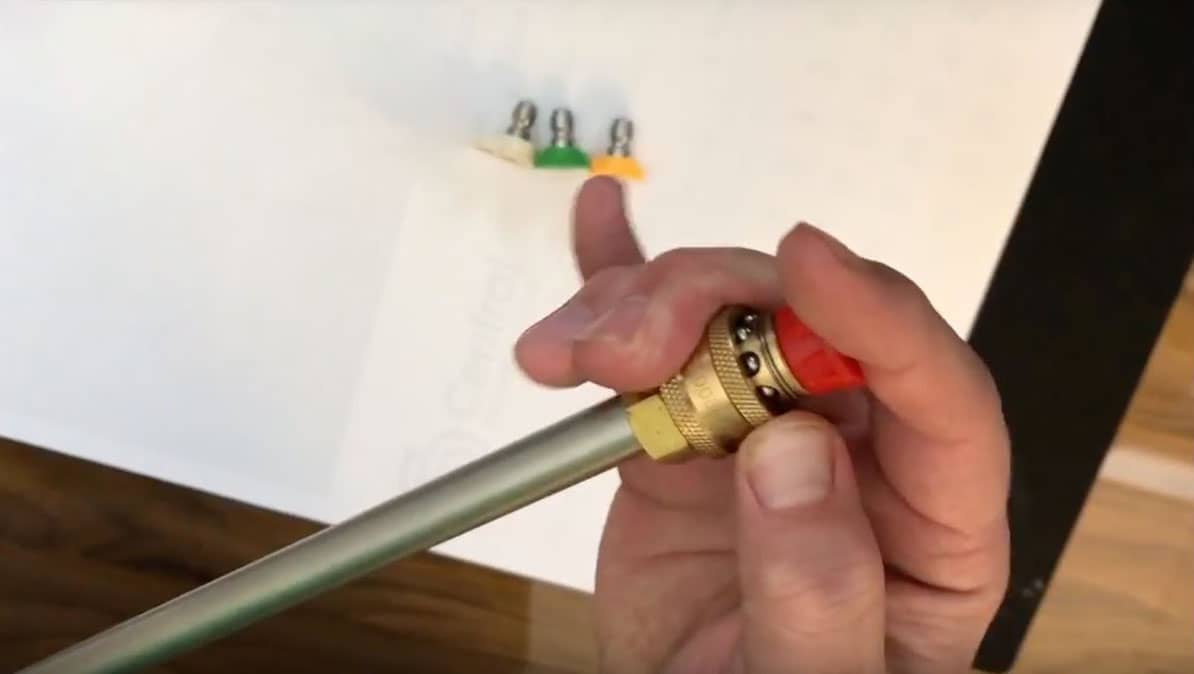
Paso 1: preparativos antes de cambiar la boquilla
- Reúna las herramientas y materiales necesarios: Boquilla, llave inglesa, trapo, manual de instrucciones.
- Lleva equipo de protección: Los guantes te protegen de la suciedad y los arañazos; las gafas bloquean los daños causados por el agua a alta presión o los residuos; la ropa de cierto grosor resiste las salpicaduras de suciedad y la presión del agua.
Paso 2: preparar la hidrolimpiadora
Antes de empezar a cambiar la boquilla, asegúrese siempre de que la hidrolimpiadora está apagada y la fuente de agua desconectada. Esto ayuda a evitar la pulverización accidental y aumenta la seguridad. Localice el interruptor o botón de encendido de su hidrolimpiadora. Normalmente se encuentra en el panel de control o cerca del mango.
Paso 3: retirar la boquilla antigua
Localice la boquilla en el extremo de la varilla o pistola del limpiador a presión. Suele tener rosca en el extremo. Si la boquilla está bien sujeta, utilice una llave inglesa o una herramienta única para aflojarla.
Es importante tener en cuenta que algunas hidrolimpiadoras pueden tener un sistema de conexión rápida, en el que la boquilla está unida a un mecanismo de liberación rápida en lugar de roscada. En estos casos, puedes extraer fácilmente la boquilla apretando las lengüetas de liberación laterales y tirando de ella.
Después de retirar la boquilla de forma segura, limpie la superficie con un paño para asegurarse de que la conexión está limpia y libre de residuos.
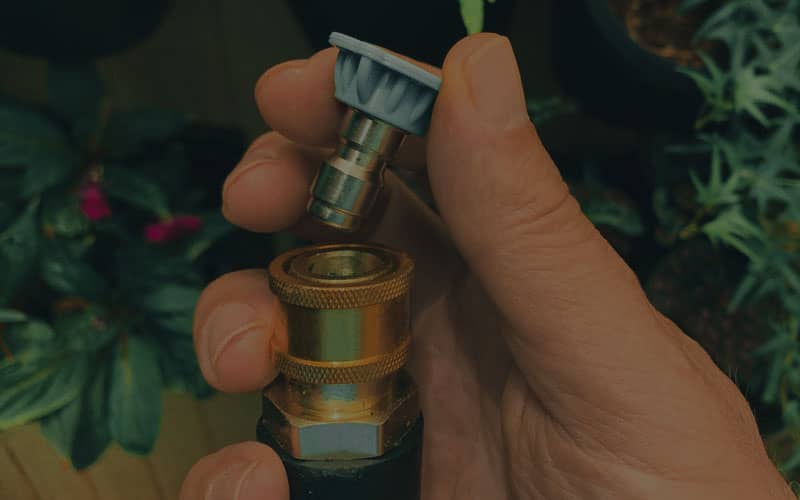
Paso 4: colocar la nueva boquilla
Una vez que haya elegido la boquilla adecuada para su tarea, es el momento de volver a colocarla en el varilla de hidrolimpiadora o pistola de lavado a presión.
Siga estos pasos para volver a colocar la boquilla correctamente:
- Asegúrese de que la boquilla y las roscas de la varilla de pulverización o de la pistola estén secas y libres de residuos.
- Alinee las roscas de la boquilla con las líneas correspondientes de la varilla de pulverización o la pistola.
- Presione la boquilla en la varilla de pulverización o en la pistola y gírela en el sentido de las agujas del reloj.
- Continúe girando la boquilla en el sentido de las agujas del reloj hasta que esté bien sujeta y apretada. Tenga cuidado de no apretarla demasiado, ya que podría sufrir daños.
- Agite suavemente la boquilla para confirmar que está bien sellada, sin holguras ni huecos.
Es esencial asegurarse de que la boquilla está correctamente fijada cuando se utiliza un limpiador a presión para evitar fugas o cambios en el patrón de pulverización. Compruebe siempre que la boquilla esté bien apretada antes de utilizar la máquina.
Paso 5: volver a poner en marcha la hidrolimpiadora
Después de haber fijado correctamente la boquilla, es esencial reiniciar la máquina para asegurarse de que todo funciona correctamente. Recuerde situarse siempre a una distancia segura cuando pruebe por primera vez la presión de la nueva boquilla.
Experimente con distintos patrones de pulverización utilizando la boquilla adecuada. Comience con un patrón de pulverización ancho y pase progresivamente a una forma más estrecha para calibrar la presión y la cobertura. Compruebe si hay fugas alrededor de las conexiones de la boquilla y verifique que el patrón de pulverización es coherente con el tipo de boquilla.
Preste atención a cualquier sonido o vibración inusual que pueda indicar un problema con la hidrolimpiadora. Si todo funciona correctamente, siga utilizando la hidrolimpiadora para las tareas de limpieza que desee.
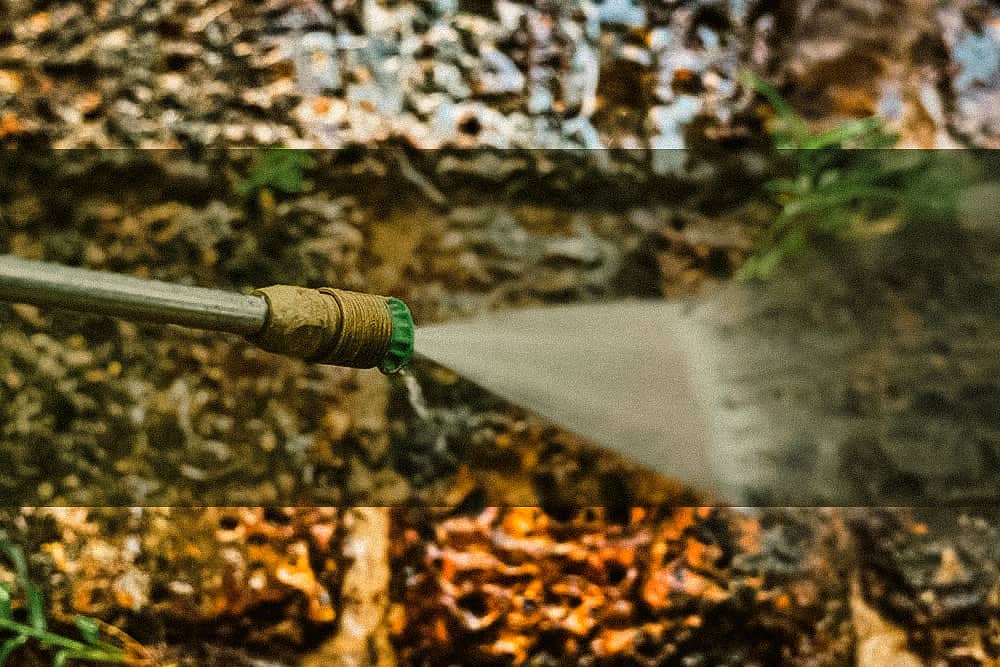
Problemas comunes y soluciones
Aunque esté correctamente instalada, pueden surgir problemas con la boquilla de su limpiadora a presión. He aquí algunos problemas comunes y soluciones recopiladas por BISON.
Fugas en la conexión de la boquilla
- La junta tórica está desgastada o dañada: Sustitúyala por una junta tórica nueva y lubríquela adecuadamente.
- La boquilla está mal instalada: Vuelva a conectar según los pasos de sustitución anteriores.
- Limpie la zona de conexión: Limpie a fondo los residuos o la corrosión en la zona de conexión de la barra de pulverización y la boquilla y vuelva a conectarla.
Patrón de pulverización deficiente
- La boquilla no es compatible con la hidrolimpiadora: Consulte el manual del usuario o la guía del fabricante para seleccionar el tamaño y el modelo de boquilla adecuados.
- Método de instalación incorrecto: Vuelva a conectar y preste atención a la alineación de los hilos al conectar.
Conclusión
Aprender a cambiar la boquilla de la hidrolimpiadora es la clave para dominar plenamente la limpieza a alta presión. La boquilla adecuada no sólo garantiza el efecto de limpieza, sino que también evita que la hidrolimpiadora de alta presión se someta a una presión innecesaria, reduciendo así las posibilidades de avería. BISON cree que con este artículo ya dominas esta habilidad por completo, ¡así que date prisa e intenta cambiarla!
BISON es un conocido fabricante de hidrolimpiadoras en China. Cada producto que suministramos se somete a una estricta inspección de calidad y satisface plenamente las necesidades de limpieza de alta intensidad en entornos de trabajo extremos. Y no sólo eso, no escatimamos en detalles. Cuando abra el equipo, comprobará que hemos instalado piezas de protección en todos los rincones. También ofrecemos personalización de productos especializados, servicio exclusivo de atención al cliente y asistencia técnica, por lo que dispondrá de los recursos y la ayuda que necesita para lograr un rendimiento óptimo. Invierta ahora en BISON y mejore la reputación de su sector.
Preguntas frecuentes sobre el cambio de la boquilla de la hidrolimpiadora
El desmontaje y la limpieza de la boquilla de la hidrolimpiadora deben determinarse en función de sus necesidades de limpieza:
- Cambio de estación: Antes de la limpieza de primavera o del almacenamiento invernal, es necesario realizar una limpieza a fondo.
- Disminución del rendimiento: Si el rendimiento se reduce o el patrón de pulverización es inconsistente, es posible que la boquilla esté obstruida o sucia y necesite limpieza.
- Tipo de trabajo: Si la lavadora se utiliza en un entorno especialmente sucio, debe desmontarse y limpiarse con frecuencia. La limpieza puede completarse cada 20-25 horas de uso para mantener una eficacia de limpieza óptima.
Sí, pero hay que asegurarse de que la hidrolimpiadora y la boquilla coincidan.
